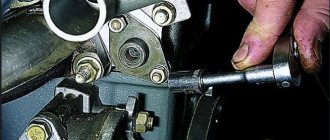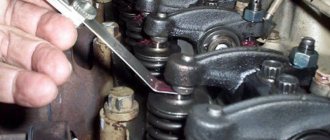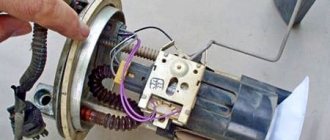The timing chain plays an important role in the operation of the gas distribution mechanism. Over time, it stretches and requires tension, since the quality of the engine depends on it. Therefore, you need to know when to check the tension and how to tension the chain on a VAZ 2101. This topic is covered in an article and a video that demonstrates the process of checking and tensioning the chain drive.
When is stretching necessary?
Chain tensioning is required in the following cases:
- after engine repair;
- after replacing the product;
- when stretched after prolonged use.
Timing belt VAZ 2101
In the first two cases, it is clear that checking the tension is necessary, since the chain was removed or replaced. In addition, you should also check that the alignment marks match. These marks are located on the crankshaft and camshaft. You can determine the need for tension by the sounds of the engine running. If the tension is weak, then during its operation extraneous noises are heard in the place where the chain drive is located. At the same time, timing parts wear out faster. Therefore, when checking the tension, it is necessary to pay attention to the condition of the damper and the shoe.
Timing tensioner shoe
If the tension is weak, the links can jump several teeth, then the valve timing will be disrupted. In this case, the car may stall, not start, and the speed will fluctuate. You can use a flathead screwdriver to check. It needs to be inserted and, using as a lever, pressed on the chain. It should not bend and be stretched like an arrow. Do not put too much pressure on the drive, although the part is metal, it is subject to deformation.
The video below looks at a VAZ 2101 car, in which a clattering sound is heard when the engine is running. It shows in detail how to check the condition of the damper, the shoe, and how to carry out tension.
In what cases is ignition installation necessary?
There are several symptoms by which a car owner can determine that it is necessary to adjust and set the ignition breaker:
- Inability to start the engine.
- Increased gasoline consumption. Of course, this may be due to the need to adjust the carburetor, but this also happens. For example, if the ignition is set later, the dynamics of the car will be low, and in order to accelerate normally, the engine needs more air-fuel mixture.
- The appearance of shots in the silencer. If the explosion follows, it will take some time for the gases to expand. In the event that the piston reaches BDC, the exhaust stroke will be next, which means that a certain part of the fuel will be transferred to the exhaust system. Accordingly, pops will appear as a result.
- The power unit began to operate noisier. You will need to install the ignition and correctly install the VAZ 2106 distributor in case of shaking and tripping of the engine. The upward piston makes the operation of the power unit more rigid, and the explosion of the mixture will occur towards it.
Setting the ignition to "six"
Step-by-step instruction
Before starting troubleshooting, check that all timing components are free of mechanical defects. To do this, you need to remove the protective cover of the drive and perform a visual inspection of the parts: sprockets, damper, tensioner and shoe. If defects are found, these components should be replaced.
Tools
Before you start work, you need to prepare the necessary tools:
- keys to “13” and “38”;
- flat screwdriver;
- pliers.
To carry out work, the car should be placed on a convenient platform and supports should be placed under the wheels so that it does not roll. The gear shift lever must be set to neutral.
Engine compartment of VAZ 2101
Stages
- First you need to find the tensioning device; it is located under the pipes near the pump. Use the key to “13” to release the tensioner. Once the chain is loosened, the shoe should pop off.
- Next, you should take the key at “38” and throw it on the crankshaft pulley nut. Then you need to turn the crankshaft a couple of turns in a clockwise direction.
- Rotate the shaft until the marks on the camshaft sprocket and on the camshaft bearing housing coincide. In this case, the spring located inside the tensioning device, acting on the shoe, will automatically perform the necessary tension.
- It is advisable to additionally check the tension using a screwdriver. If everything is normal, then we return to the tensioner and tighten its head with a wrench.
Checking tension with a screwdriver
After tightening the chain drive, you should start the engine and check its operation. It should work without extraneous noise. If the noise remains after tensioning, then the reason may be in the damper. Then you need to check its serviceability and replace it if necessary. It may not be possible to tension the chain drive the first time, so this procedure will have to be repeated several times.
During the procedure, it is necessary to ensure that the marks match so that the valve timing does not go astray.
This operation should be carried out every time after any repair work. In addition, a preventive check should be performed after the 10 thousand kilometers mark. If you learn how to check and tension yourself, this will make it possible to extend its service life and save on car service costs.
Dismantling and replacement
Regardless of the design, where the part is located, it is important to remove and install it in the same order. Depending on the location of the motor, the part is located in the front part behind the cooling radiator
But if the motor is placed across the engine compartment, then your hand will not reach the part. Because to remove the crankshaft pulley you need to remove the right wheel
If it is difficult to change, it makes sense to pay attention to the drawing, the work will speed up
The vehicle is rolled onto the inspection hole and secured so that the car does not move from its place. To get there and remove the structure, you need to unscrew all the parts that impede access (air filter, mud flaps, etc.). Remove the generator belt. Next, open the clutch block plug and insert a pry bar into the hole to lock the flywheel.
The elements of the part are characterized by strong fixation, so they are not easy to remove. To turn a part, it is necessary to make a lot of effort. If dismantling is performed for the first time, it will be difficult to unscrew the crankshaft pulley. The reason is that factory production is characterized by strong tightening of the component parts.
How to unscrew the crankshaft pulley nut
When turning fasteners, it is important to follow the recommendations, then the process will take at least 15 minutes. The effort should be applied as close to the camshaft as possible:
- use a pry bar to pry it up from all sides;
- If necessary, use a special universal crankshaft pulley puller for this part.
The device is presented in the form of a hairpin with 2-3 grips. The end of the gripper is secured to the edges of the part, and the end of the pin is placed in the middle of the shaft.
Scroll clockwise. But not all brands of cars turn clockwise; in some cars, work must be done in the opposite direction
In this case, it is important to put your gear lever in 4th speed and turn on the handbrake
If you can’t turn it, the lever should be in the neutral position. The next step is to remove the candlesticks. The key is placed on the floor or on the rear side member and turned in the direction of movement of the device.
All maneuvers make it easier to scroll, so further actions must be performed manually; if necessary, lubricate with brake fluid or WD grease. In addition, tapping the edges of the head can make your work easier.
How to remove the crankshaft pulley bolt
To do the job efficiently, the disassembled machine is placed on a stump. The pin holds the part together and is usually found in front-wheel drive automatic cars. The thread is designed in such a way that it is tightened during the torque when moving.
It is necessary to perform actions that open access to the base
To do this, it is important to stop the rotation well. A mount is used as a fixation
The tool is inserted into the flywheel gears. It must be adjusted securely so that it does not fall out during the turning process. Therefore, it is better to do the work with an assistant. Next, put a socket head of the same diameter as the pin onto the pin, attach a lever and an extension (a piece of durable pipe). After this they begin to slowly unscrew it.
People's automobile experience
The difficulty of dismantling lies in the specially selected strong connection, without play. The fasteners are tightly screwed. They practice using a pry bar, while slowly pressing on the back surface of the part.
When purchasing a part, you must have new fasteners. You will need a front oil seal, hanging belts
When purchasing, you need to pay attention to the grooves and marks. They must be free of defects
Otherwise, after a while you need to replace everything with a new one.
Installing the pulley on the crankshaft
To properly install the crankshaft pulley, it is necessary to lubricate it with grease or other viscous agent. This will make the fastener installation process easier. To put it on, tilt the washer slightly to the side and pull it onto the base. Next, you can use a tapping motion with a hammer to process the hub through a soft rubber gasket. Then, in the reverse order, you need to tighten the other parts of the car.
Video “Timing chain tension on classics”
This video demonstrates how to tension a chain in a classic VAZ.
Welcome! Chain tensioner - don’t know what it is? Before you start replacing, we advise you to read a short article about the tensioner, in which everything about it will be described in detail. (See “What is a chain tensioner for?”)
Note! To replace the tensioner, stock up on: A basic set of wrenches, and if you have it, you can also use a “13” spanner!
Question? Which brand of chain tensioner will you install on your car and why did you choose it? (Write your answer in the comments)
When should you change the timing chain tensioner? It must be replaced if:
- The car began to operate unstably, or if various sounds appeared in the area where the timing chain is located.
Note! If you want to know what sounds the engine will make if the chain tensioner is faulty, then in this case, start the video at the very end and watch its beginning, and you will understand everything!
- The tensioner also needs to be replaced if it no longer holds the chain in a tense state due to the fact that it has become deformed.
Note! You can also try adjusting the timing chain! (For information on how to adjust the timing chain, see the article “Adjusting the timing chain on the VAZ 2101-VAZ 2107”)
Installation of damper VAZ 2107
Installation of the damper is carried out in the reverse order. In this case, you should tension the chain and check the positions of the marks on the camshaft and crankshaft of the engine.
The seats of the damper mounting bolts must be lubricated with sealant. This will prevent oil from seeping through.
Sometimes a car enthusiast encounters extraneous sounds that come from the area of the front engine cover and resemble a kind of tapping. This may be a sign that the chain guide needs to be replaced. The damper on the VAZ 2107 model is necessary to soften the vibrations of the chain during its rotation. If you can clearly hear a clattering or metallic tapping sound, this means that the damper is very worn and needs to be urgently replaced. Another possible cause of the problem is that the chain tension is too loose. In this car model, the damper is located on the left, in front of the cylinder block. Use the diagram supplied with the machine to determine the exact location of the part to be replaced.
Dismantling the timing belt on a VAZ 2106
Timing belt with chain drive on VAZ 2101
The “kopek”, like all other “classic” models, has a timing chain drive. The mechanism consists of a double-row metal chain and additional elements that ensure its tension and prevent vibrations. The well-coordinated operation of the motor directly depends on the integrity and serviceability of each part of the mechanism. The chain drive connects the crankshaft and camshaft and ensures their synchronous operation. When the shafts rotate, the pistons in the engine cylinders are set in motion, and the valves in the cylinder head (cylinder head) open and close in a timely manner.
Tranquilizer
The damper performs the function of damping circuit vibrations. Without it, the chain may jump or fly off the sprockets of the timing mechanism. If the damper breaks down, the drive may simply break off. Such a nuisance is possible at high engine speeds. If the chain breaks, the pistons and valves are damaged, requiring expensive repairs. Therefore, the condition of the damper must be monitored and replaced in a timely manner. The part is a durable metal plate with special holes for fastening.
Opposite the damper there is a shoe, which is also responsible for calming and tensioning the chain. It is made of a special polymer material, which gives the part high wear resistance.
Tensioner
The “penny” chain drive tensioner prevents the chain from loosening when the motor is running. The element comes in several types:
- auto;
- mechanical;
- hydraulic.
Automatic tensioners began to be produced recently, but with regard to this part, it is already possible to note the pros and cons. The main positive point is that there is no need to make periodic adjustments, i.e. the drive is constantly in tension. The disadvantages include fairly quick failure and high cost of the part. In addition, based on reviews from car enthusiasts, the auto tensioner does not tension the chain very well.
The operation of hydraulic devices is based on the supply of oil under pressure from the engine lubrication system. With this design, the driver does not need to worry about periodically tightening the chain. However, over time, the part may malfunction, which manifests itself in the form of jamming of the mechanism.
The VAZ classic uses a mechanical tensioner. The part has a significant drawback: over time, it becomes clogged with small particles, the plunger jams and the device loses its ability to produce tension.
One of the key elements of the timing chain drive is the chain itself, made of metal and having a certain number of links: on the VAZ 2101 there are 114 of them. Compared to a belt drive, the chain is more reliable and has a longer service life.
Depending on the quality of the chain and the operating conditions of the vehicle, it is replaced every 60–100 thousand km. There are cases that a part lasts for 200 thousand km, but it’s hardly worth the risk, because a broken chain will result in a much more expensive repair than its timely replacement.
The chain is tightened every 10 thousand km, even in the absence of signs indicating sagging.
Construction and repair of a contactless distributor
The design of the distributor, operating in conjunction with the electronic ignition system, is identical to the design of a mechanical distributor. There is also a plate with a bearing, a slider, a centrifugal regulator and a vacuum corrector. Only instead of a contact group and a capacitor, a magnetic Hall sensor is installed plus a metal screen mounted on the shaft.
In a contactless distributor, the main role is played by a magnetic sensor that sends signals to the switch
How a contactless distributor works:
- The Hall sensor and permanent magnet are located on a movable platform, and a screen with slots rotates between them.
- When the screen blocks the magnet field, the sensor is inactive and the voltage at the terminals is zero.
- When the roller turns and passes through the slot, the magnetic field reaches the sensor surface. At the output of the element, a voltage appears that is transmitted to the electronic unit - the switch. The latter gives a signal to the coil, which produces a discharge that goes to the distributor slider.
In an electronic ignition system, spark generation is carried out by a switch and a coil; the distributor only determines the moment the discharge is applied to the spark plugs
The non-contact distributor is more reliable in operation - the Hall sensor and bearings become unusable much less often due to the lack of mechanical load. A sign of meter failure is the absence of a spark and complete failure of the ignition system. Replacement is easy - you need to disassemble the distributor, unscrew the 2 screws securing the sensor and pull the connecting connector out of the groove.
The magnetic sensor is attached with two screws to the bearing pad
Malfunctions of the remaining elements of the distributor are similar to the old contact version. Troubleshooting methods are described in detail in the previous sections.
Chain mechanism fault detection
The timing drive, equipped with a chain, is structurally located inside the engine. To determine the condition of the parts of this mechanism, it is necessary to partially disassemble the motor. The fact that there are problems with the chain or drive elements is indicated by characteristic signs.
The chain is noisy
A circuit can have different types of noise:
- noise under load;
- knocking on a warm engine;
- extraneous sounds when cold;
- constant noise with a metallic character.
If the motor begins to make sounds that are uncharacteristic of its normal operation, it is necessary to find out as soon as possible what problems have arisen with the chain drive and eliminate them. If this is not done, wear on the timing drive elements will increase, which can lead to costly repairs.
Video: chain knocking in a VAZ “classic” engine
Timing drive components may fail prematurely for the following reasons:
- the use of oil not specified by the car factory, or its untimely replacement;
- use of low-quality parts;
- low lubricant pressure in the engine;
- failure to comply with engine maintenance regulations;
- low quality of repairs.
Often the chain is noisy due to stretching or problems with the tensioner. Attempts to tighten it turn out to be useless, and the engine sounds like a diesel engine. The sound most often appears on a cold engine when idling.
Jumped the chain
With high mileage of the vehicle, the timing chain stretches. As a result, it can simply jump to other teeth of the camshaft or crankshaft gears. This problem may occur when the timing drive parts are damaged. If the chain jumps by at least one tooth, the ignition is greatly shifted and engine operation becomes unstable (sneezes, shoots, etc.). To fix the problem, you will need to check the integrity of the parts, and if damage is detected, make repairs.
There is a problem with the contacts in the distributor - they are burning!
February 20, 2013, 00:30 #1
VAZ-2107, late 80s, the contacts in the switch-distributor are constantly burning, they installed modern, “antique” ones, with and without a hole, remade Moskvich ones, etc., installed capacitors of various capacities, installed two condensers - the same result and the same thing - after 300 - 400 km the contacts burned out, the engine began to stall and, in the end, you have to stop and clean the contacts! On-board network voltage - the voltmeter needle is at the end of the green scale. Kotushki were installed in a variety of varieties - from modern to “made in the USSR” or “Hungary”.
Does anyone else have glitches like this? How to overcome them? Thank you for your attention. ZIL 5301 BychokZIS 101
ZIL 5301 BychokZIS 101
February 20, 2013, 01:42 #2 + 1
DrachOl, February 20, 2013, 00:30, #1
VAZ-2107, late 80s, the contacts in the switch-distributor are constantly burning, they installed modern, “antique” ones, with and without a hole, remade Moskvich ones, etc., installed capacitors of various capacities, installed two condensers - the same result and the same thing - after 300 - 400 km the contacts burned out, the engine began to stall and, in the end, you have to stop and clean the contacts! On-board network voltage - the voltmeter needle is at the end of the green scale. Kotushki were installed in a variety of varieties - from modern to “made in the USSR” or “Hungary”.
Does anyone else have glitches like this? How to overcome them? Thank you for your attention. There is only one solution: install electronic
There is only one solution: install electronic
Sold as a set of trampler + coil + switch price 1.5-2 thousand
February 21, 2013, 08:10 #3
I had it on a six, but the contacts burned out almost immediately, it was cured by replacing the ignition coil, but I think it was a matter of spare parts and the correct adjustment of the gaps.
February 21, 2013, 11:27 #4 + 1
DrachOl, February 20, 2013, 00:30, #1
VAZ-2107, late 80s, the contacts in the switch-distributor are constantly burning, they installed modern, “antique” ones, with and without a hole, remade Moskvich ones, etc., installed capacitors of various capacities, installed two condensers - the same result and the same thing - after 300 - 400 km the contacts burned out, the engine began to stall and, in the end, you have to stop and clean the contacts! On-board network voltage - the voltmeter needle is at the end of the green scale. Kotushki were installed in a variety of varieties - from modern to “made in the USSR” or “Hungary”.
Does anyone else have glitches like this? How to overcome them? Thank you for your attention. The contacts are burning - high interruption current due to: low consumer resistance (coil), current leakage in the wires, large capacitor capacity, increased gap
Something like this. Try to install a coil with a higher resistance, and radically use the advice of the OLEGator (see above)
The contacts are burning - high interruption current due to: low resistance of the consumer (coil), current leakage in the wires, large capacitor capacity, increased gap. Something like this. Try to install a coil with a higher resistance, and radically use the advice of the OLEGator (see above).
Timing chain repair VAZ 2101
On the first model Zhiguli, the timing chain drive consists of several elements, the condition of which determines the operation of the entire mechanism as a whole. If any of these parts fail, repairs must be carried out immediately. Let's look at the step-by-step steps for replacing the timing drive components on a “penny”.
Replacing the damper
Before you begin repairs, you need to take care of preparing the appropriate tools and materials. You will need:
- screwdrivers;
- a set of keys;
- new chain guide;
- wire hook.
After preparing everything necessary, we begin the repair in this order:
- After unscrewing the fasteners, remove the air filter box.
Replacing the tensioner
The chain tension device on the “classic” is located in the cylinder head below the cooling system pipe above the pump. To replace the part, use the same tools as for repair work with the damper, but you will additionally need a wrench to turn the crankshaft. Actions boil down to the following steps:
- Using a 10 mm wrench, unscrew the tensioner fastener to the cylinder head.
Replacing the shoe
The shoe is changed with the same tools as when working with the damper. Repairs are carried out as follows:
- Remove the engine sump protection plate.
Chain replacement
The chain on the “penny” is changed with the following tools:
- hammer;
- screwdrivers;
- spanners;
- mounting blade;
- a piece of wire;
- key for turning the crankshaft.
After preparation, we proceed to disassembly:
- We repeat the steps to replace the damper up to point 6 and the shoe up to point 8 inclusive.
- Rotate the crankshaft until the mark on the camshaft sprocket aligns with the protrusion on its housing. The mark on the crankshaft should be positioned opposite the mark on the timing cover.
The chain drive is installed in the following order:
- We put the chain on the crankshaft sprocket and on the gear of the auxiliary devices.
Video: how to change the chain on a “classic”
You don’t know anything about adjusting the ignition!
Greetings to VAZ car enthusiasts on the RtiIvaz.ru blog! You don’t know anything about ignition adjustment, which is why you need to read the auto article further.
Stable engine operation, its efficiency, throttle response, and power depend on the correct installation of the ignition. The ignition adjustment itself is necessary in order to ignite the fuel-air mixture in a strictly defined sequence, depending on the order of operation of the cylinders.
For self-service, owners of these models need to remember that on VAZ 2105, 2106-07 cars the cylinder operating order is 1-3-4-2.
The operation of adjusting the ignition on VAZ 2105 and VAZ 2106-07 cars may be required in several cases. This must be done after a medium or major overhaul of the engine, replacing the block gasket, valve burnout, replacing the timing chain or belt, replacing the camshaft and other similar cases associated with partial disassembly of the engine.
To set the top dead center and adjust the ignition, there are special marks on the engine in its upper and lower front parts that must be aligned. Location of marks on VAZ 2106 and VAZ 2105 engines for adjusting the ignition system.
Installing the chain by marks
The need to install marks on the timing mechanism may arise during the repair process or when the chain is severely stretched. If the marks do not match, the stable operation of the motor is disrupted due to a phase shift. In this case, an adjustment is required. The work is carried out with the following tools:
- Screwdriver Set;
- key for rotating the crankshaft;
- a set of keys.
We carry out the procedure according to the following instructions:
- We dismantle the air filter box and the valve cover with the seal by unscrewing the fasteners.
- Loosen the tensioner clamp, press the screwdriver against the shoe and tighten the nut.
- Using a 38 mm wrench or a crank, turn the crankshaft until the marks on its pulley and the timing cover match, and the mark on the camshaft sprocket should be located opposite the protrusion cast on the body.
- If any of the marks do not coincide, turn on the fourth speed and unbend the lock washer on the camshaft sprocket.
- We unscrew the bolt and remove the gear.
- Remove the chain from the sprocket and set the desired position (step 3). After installing the marks, we perform reverse assembly.
Video: how to set timing marks on classic Zhiguli cars
Main reasons
Welding of liners with crankshaft journals due to oil starvation. Jamming of piston pins in the upper piston head. As with liners, the cause may be oil starvation. But the pin also jams due to misalignment of the upper head and piston pin. Due to the resulting misalignment, local zones of semi-dry friction and excessive tension appear, which can cause critical thermal expansion, scuffing and jamming. The piston is stuck in the cylinder due to engine overheating or poor heat dissipation. A broken piston blocks the movement of the connecting rod and the rotation of the crankshaft. Unqualified engine repair. Incorrect choice of thermal clearances when assembling the CPG, crankshaft, or unresolved malfunctions of the lubrication system can cause the breakdowns described above
Also, the cause of the wedge can be bolts and nuts accidentally dropped into the cylinders or intake tract. A bent valve is blocking piston movement
The main reason for the “meeting” of valves with pistons is a broken timing belt. After a break or jump on several teeth of the timing chain at once and an impact, the valve stem bends. Severe deformation leads to the fact that the valve cannot move along the guide and blocks the movement of the piston on the approach to TDC. Valve desiccation will lead to similar consequences.
Adjusting chain tension
The need to tighten the chain may be necessary in different situations:
- engine repair;
- replacing the chain drive;
- chain stretching.
To work you will need the following tools:
- 13 and 38 mm keys;
- flat screwdriver;
- pliers.
Tensioning the chain consists of several steps:
- We place the car on a flat surface, turn on neutral, placing stops under the wheels.
- We unscrew the chain tensioner clamp, and a characteristic click will be heard.
- Use a 38 mm wrench to rotate the crankshaft, making several revolutions.
- Stop rotation at maximum force and tighten the tensioner nut.
If the valve cover is removed, you can determine the tension of the chain by pressing it with a screwdriver . If the chain is tensioned normally, it will be stiff.
Purpose and design of the drive
The gas distribution mechanism is responsible for supplying the fuel mixture to the cylinders and releasing exhaust gases. To ensure timely opening of the intake and exhaust valves, the camshaft must rotate synchronously with the crankshaft. In the Zhiguli, this function is assigned to a chain drive installed in the front of the engine.
Replacing the timing chain and gears cannot be classified as complex operations, but the procedure is quite labor-intensive. To do the work yourself, you need to understand the operating principle and design of the drive, which consists of the following elements:
The gear size ratio is approximately 1:2. That is, while the crankshaft drive sprocket makes 2 revolutions, the camshaft gear rotates 1 time.
The required tension of the VAZ 2106 timing drive is provided by a plunger device supporting a semicircular shoe. Older cars were equipped with a purely mechanical plunger - a retractable rod with a powerful spring, which had to be tightened manually. Later models received a hydraulic chain tensioner that operates automatically.
Unknowingly, I once found myself in a stupid situation. A friend’s chain on the “six” was stretched out and began to make a lot of noise, I advised it to be tightened. On site it turned out that the plunger fixing bolt was missing; the advice turned out to be useless. Later it turned out that the car has an automatic tensioner that is activated by oil pressure. The stretched chain had to be replaced.
The timing drive is lubricated by engine oil coming from the camshaft. To prevent lubricant from splashing, the mechanism is hidden behind a sealed aluminum cover, screwed to the end of the cylinder block with 9 M6 bolts. Another 3 screws connect the protective casing to the oil pan.
So, the chain drive performs 3 functions:
Why adjust the ignition?
At the beginning of the article we already touched upon the problem of detonation. But that is not all. The fact is that an engine is a very precise device where all processes must take place on time. This is necessary so that the fuel mixture burns efficiently, thereby ensuring power delivery. If the mixture ignites at a large distance before TDC, detonation will occur. This is early ignition.
If the mixture ignites when the piston is already at top dead center, the mixture will not burn completely. As a result, you can not expect full power delivery. In addition, the car will definitely have increased fuel consumption, and the engine itself will operate unstably. This all indicates that the car has a late ignition.
Valve lid
The valve cover covers and seals the timing belt, preventing grease from camshaft, valves and other parts from leaking out. In addition, new engine oil is poured through its neck when replacing. Therefore, a sealing gasket is installed between the valve cover and the cylinder head, which is changed every time after repair or adjustment of the valves.
Before replacing it, you should thoroughly wipe the surfaces of the cylinder head and cover to remove any remaining engine oil. Then the gasket is put on the cylinder head studs and pressed with the lid. It is necessary that the gasket fits exactly into the grooves of the cover. After this, the fastening nuts are tightened in a strictly defined sequence.











